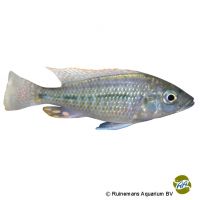Rainbow Haplochromis (Protomelas similis)
| Rainbow Haplochromis Protomelas similis | |
|---|---|
| Name | Rainbow Haplochromis |
| Name Lat. | Protomelas similis |
| Synonym | Haplochromis similis |
| Family | Cichlids |
| Family lat. | Cichlidae |
| Order | Cichlids |
| Order lat. | Cichliformes |
| Origin | Lake Malawi |
| Habitat | Shallow water |
| Diet | Omnivore |
| pH | 7.5-8.8 |
| Behavior | Semi-aggressive |
| Keeping | Harem |
| Care Level | Difficult |
| Reproduction | Mouthbrooder |
| Breeding | Moderately difficult |
| Life Span | 6-10 years |
| Protection | No |
| Metric Units | |
| Size | 15-17 cm |
| Temperature | 24-28 °C |
| Hardness | 10-25 °dH |
| Aquarium | ~ 400 l |
| US Units | |
| Size | 6"-6.7" |
| Temperature | 75-82 °F |
| Hardness | 178-445 ppm |
| Aquarium | ~ 100 gal |
Distribution and habitat
Similis Malawi cichlids are found exclusively (endemically) in Lake Malawi, where they are widespread throughout the lake and have produced several site variants that differ in coloration. They live in shallow water with dense vegetation.
Maintenance
The aquarium should have dense planting, with some rocks and free sand areas, as well as provide adequate swimming space
No ammonia, ammonium and nitrite should be detectable, the nitrate value should not exceed 100 mg/l. To ensure the water quality and oxygen content, a filter and heater adapted to the aquarium size is required, as well as lighting for the species-appropriate day-night rhythm of the animals.
Diet
They feed mainly on vallisneria. The food supply consists mainly of vegetable food, such as algae leaves, crushed peas, mashed leafy and wild vegetables, as well as dry food with vegetable components, such as kelp and spirulina. In addition, some live food, such as Artemia, Daphnia and black mosquito larvae, which is also accepted in frozen form, supplemented with frozen special food mixtures for plankton feeders.
It is recommended to feed small portions several times a day, which are eaten within a few minutes. A regular and varied diet promotes health and increases resistance.
Behaviour and compatibility
These Malawi cichlids are relatively peaceful, but assertive. Males occupy territories, which they defend vigorously during spawning season. They should be maintained in a harem, one male with several females. Keeping multiple harems is only recommended in a larger and richly structured tank. They can be socialized well with other cichlids from Lake Malawi.
Basically, only compatible fish species with similar demands on water condition and water temperature may be socialized.
Sex dimorphism
The sexes differ clearly in coloration (sexual dichromatism). The male is much more colorful and has longer extended fins
Reproduction and breeding
They are maternal mouth breeders. The males establish round spawning sites among vallisneria and try to attract females there that are ready to spawn. Immediately after spawning, the females pick up the eggs in their throat sac for mouthbrooding. They retain the fry in their throat sac even after hatching. After about 3 weeks, the fry are released and brood care ends. During the entire brood care, the female does not take any food.
Fry must be fed several times a day with special rearing food (Artemia nauplii). In community tanks breeding is hardly possible, because the fry is easy prey.
Important
Different location or color varieties of Similis malawi cichlids should not be maintained together, as undesirable crossbreeding (hybridization) may occur.
The well-being of the fish should be monitored regularly. Temperature should be checked daily, pH, hardness and nitrate levels should be checked at least every 14 days. Regular partial water changes are recommended, even if the contaminant level has not yet reached the upper limit. Sudden changes in water quality should be avoided. Newly introduced fish must be accustomed slowly to the water in the aquarium.
Further literature can be found in your pet store.
References
Text: Werner Winter; Image: Ruinemans Aquarium B.V.
Source: BMEL (1998): Tierschutzgutachten - Haltung von Zierfischen (Süßwasser); RIEHL & BAENSCH (2004): Aquarien Atlas Bd. 3, Mergus Verlag; ENGELMANN (2005): Zootierhaltung - Tiere in menschlicher Obhut: Fische, Verlag Harri Deutsch
- Gemäß § 21 Abs. 5 Tierschutzgesetz idgF
